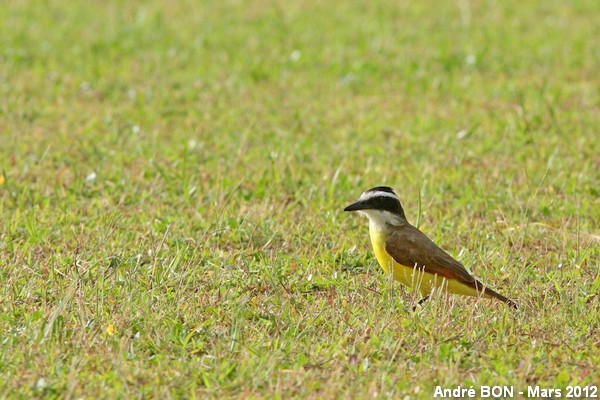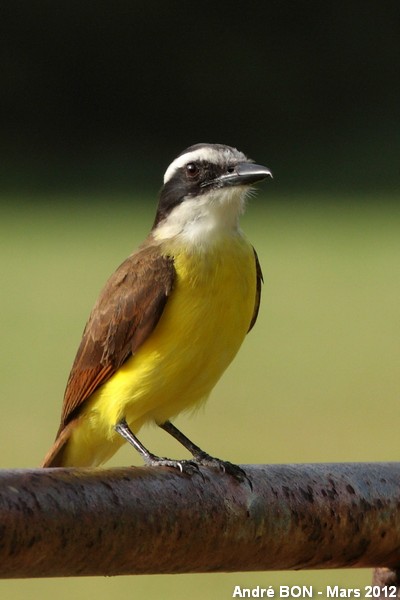

| Great Kiskadee (Pitangus sulphuratus (Linnaeus, 1766)) |


|
|
Scientific name: Pitangus sulphuratus (Linnaeus, 1766) Common name: Great Kiskadee French name: Tyran quiquivi Order: Passeriformes Family: Tyrannidae Size: Body size: 21 to 27 cm; Wingspan: 37 to 39 cm; Weight: 52 to 68 g. Habitat: Open woodlands, copses, river banks, parks and gardens. The Great Kiskadee is missing in dense primary forests. Food: Omnivorous. The Great Kiskadee dives into water to catch fishes, tadpoles or frogs. It also feeds on insects (often caught in flight), on worms, on lizards and on fruits. It may feed on seeds when other food becomes rare. Nesting: The nests are large, about 25 cm in diameter, and surmounted by a dome. They are located on very various supports, trees, bushes, poles, roofs, cavities, etc.. The breeding season varies depending on latitude. Each clutch has from 3 to 5 eggs. Migration: Sedentary. Some populations from Argentina or southern Brazil slightly move northwards during the southern winter. Geographic area: South of the United States, Central America, South America. Missing in the Andes. |
The Great Kiskadee shows a black cap with a yellow patch on the top of the head (often hidden and only visible when feathers ere erected during nuptial display of behaviour of defence for example). Then a wide white eyebrow crosses all the head. One black stripe, on the eyes, draws one kind of mask. The cheeks, the chin and the throat are white. The under side of the body is bright yellow. The upper side is olive brown with russet colour on the edges. The strong and short bill is black. The legs are blackish. The common name of the Great Kiskadee comes from its trisyllabic song, " BEE-tee-WEE", becoming "bem-te-vi" in Brazil, "bien-te-veo" in Spanish speaking countries or "Kiskadee" in English. There are other Tyrant flycatcher species with a bright yellow underside and a black eye stripe on a white ground colour. The Boat-billed Flycatcher (Megarynchus pitangua) is slightly larger and shows a very strong bill whose upper edge is clearly curved. There is no russet colour on the upper side. The Lesser Kiskadee (Philohydor lictor) is smaller than the Great Kiskadee. Its bill is longer and thinner. |
| [To know more about the Great Kiskadee] [Next picture] [Top] |

|
I have shot this picture at Awala-Yalimapo not far from the beach called les Hattes. The edge of the wings is clearly russet. The bill seems to me rather short and strong. So I think this is the Great Kiskadee species. Assessing the size of a bird in the field requires experience and I do not have any about birds of South America. So I have not used this criterion though it is often cited as important for Tyrant flycatchers. |
| [To know more about the Great Kiskadee] [Previous picture] [Top] |

|
Here is the same bird as above. You can better see the shape of the bill on this picture. |